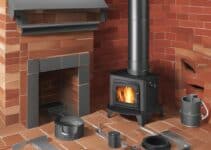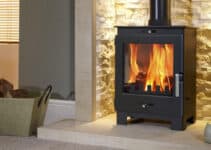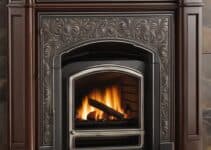In the midst of cultivating a quaint aesthetic within our homes, the appeal of a log burner can be strong. They invoke images of cosy, rustic living, yet as a seasoned journalist within the home and lifestyle niche, my responsibility is to delve beyond the charming facade. I aim to illuminate the less discussed aspects of these traditional heating elements, specifically the disadvantages of a log burner. With this in mind, we must consider the breadth of issues with log burners that extend from environmental impacts to notable log burner drawbacks affecting our health and safety.
Before exploring the myriad of log burner cons, let’s place the following image that encapsulates the essence of our discussion.
The debate on whether to adopt such a feature in one’s dwellings is compelling, and it encourages a thorough appraisal of the system’s flaws. It is my endeavour to bring forth a balanced perspective, fostering informed decisions when it comes to integrating log burners into our cherished spaces.
Overview of Log Burner Disadvantages
As someone who values the comfort and ambience that a log burner can bring to a home, it’s my responsibility to also highlight the significant drawbacks of using a log burner that have been increasingly brought to light. Recent dialogues among health professionals have unveiled pressing concerns surrounding these homely installations, and it’s imperative that we engage with this information critically.
Introduction to Rising Concerns Among Health Experts
Organizations such as Asthma UK and the British Lung Foundation have drawn attention to the adverse effects of log burners on public health. My interest in this subject was piqued by their findings on the contribution that log burners make to indoor levels of fine particulate matter (PM2.5), pushing me to delve deeper into the implications on our health and well-being. Health experts advise reducing the usage of such stoves, suggesting that they should only be relied upon when other heating options are non-existent or inadequate.
Recent Trends and Surging Popularity
The contradiction between the advice of health professionals and the sales data of log burners is stark. Despite clear warnings, log burners continue to be a sought-after item in many households. Sales reports indicate that approximately 175,000 units move annually, reflecting the challenge of aligning public health interests with consumer behaviour. This dichotomy forms the crux of the discussion on log burners and their disadvantages, and it compels us to re-evaluate our choices in the context of the broader community health narrative.
In an effort to present a balanced view, below is a summary of key considerations surrounding the use of log burners:
| Consideration | Details |
|---|---|
| Air Quality Concerns | Log burners significantly increase indoor levels of PM2.5, which can be detrimental to respiratory health. |
| Health Expert Advices | Minimise usage and seek alternatives where possible, due to the health risks posed. |
| Market Popularity | Sales remain high despite health warnings, suggesting a dichotomy between consumer trends and health advisories. |
It’s vital for us as consumers to not only appreciate the cosy comfort our log burners may provide on a chilly evening but also to remain acutely aware of the potential log burners and their disadvantages, which can have lasting impacts on our health and environment.
The Impact of Log Burners on Indoor Air Quality
As a dedicated advocate for clean air and a healthy living environment, I often turn to reputable sources such as The Guardian to understand the implications of certain lifestyle choices. It has been reported, alarmingly, that the use of log burners, while cosy and inviting, can actually have significant downsides. One of the most pressing concerns is the deterioration of indoor air quality, an issue that I find deeply troubling given our enclosed living spaces.
Upon igniting wood in these burners, we potentially introduce an array of toxins into our homes, which include carbon monoxide, a range of volatile organic compounds, and particulate pollution. These substances do not respect the sanctuary of our personal spaces, permeating the air we breath and possibly inflicting harm upon our most vital organs. The drawbacks of such pollution are manifest in elevated risks of heart disease and lung issues, among other serious health conditions.
To visualise this concern, let’s consider the nature and impact of these airborne particulates:
| Particulate Matter | Sources from Log Burners | Potential Health Impacts |
|---|---|---|
| Carbon Monoxide (CO) | Incomplete combustion of wood | Impairment of blood’s oxygen-carrying capacity, leading to cardiovascular issues |
| Volatile Organic Compounds (VOCs) | Emission of gases from burned wood | Aggravation of respiratory conditions, headaches, and dizziness |
| Particulate Matter (PM2.5) | Fine soot particles in wood smoke | Respiratory inflammation, exacerbation of asthma, and potential development of lung diseases |
Considering these facts, the log burner disadvantages are not to be underestimated. The charm of a roaring log fire masks the unseen dangers lurking in the smoke. Hence, it is incumbent upon us to weigh the aesthetic allure of log burners against the imperative to protect our health and well-being. We must question if the traditional ambiance is worth the compromised indoor air quality, which should be a haven of safety and cleanliness in our lives.
“The introduction of log burners into our homes requires us to scrutinise the potential for harm they bring to our sanctuary of wellbeing. I remain vigilant in this regard, steadfast in my resolve for a healthier indoors.”
My ongoing quest for a balance between comfort and health continues, as I caution others to be aware of the potential log burner drawbacks that might undermine the very essence of a safe home environment.
Health Issues Associated with Log Burner Emissions
When it comes to understanding the consequences of log burner emissions, it’s vital to assess both the immediate and long-term health risks associated with indoor air pollution from these popular stoves. My ongoing research shines a light on the severity of these health issues which are triggering warnings from respiratory health professionals across the globe.
Risks to Respiratory Health
At the forefront of health concerns linked with log burners is the detrimental impact on respiratory health. Asthma UK and the British Lung Foundation highlight the acute respiratory risks posed, particularly to those with existing conditions. I’ve observed how log burner emissions can exacerbate symptoms of asthma and chronic obstructive pulmonary disease (COPD), making it difficult for sufferers to manage their conditions.
- Increase in asthma attacks
- Heightened symptom severity for COPD sufferers
- Potential trigger for bronchitis and other respiratory infections
Dr Nick Hopkinson, medical director and a leading authority on respiratory health at the Asthma UK and British Lung Foundation, states unequivocally that particulate matter from log burners has a significant association with adverse health outcomes. These can range from temporary irritation to precipitating life-threatening conditions.
Long-Term Health Consequences
It’s not just the immediate effects of log burner emissions that concern me; the long-term implications demand our undivided attention too. Extensive studies have drawn correlations between the emissions from log burners and serious long-term health issues that can affect all age groups, particularly the most vulnerable populations such as children and the elderly.
“Persistent exposure to the fine particulates from log burner emissions can lead to chronic health conditions, ominous in their intensity and duration,” Dr Hopkinson has warned.
- Increased risk of heart attacks and strokes
- Potential for lung cancer from prolonged exposure
- Developmental risks in children and unborn babies due to inhaled pollutants
It’s no exaggeration to say that the health issues with log burners are an exigent matter that requires our collective action, balancing the charm and warmth they may bring with the stark reality of their impact on our health.
The Environmental Cost of Using a Log Burner
As I delve into the details regarding the environmental impact of log burners, it becomes clear that the picturesque vision of a cosy fireplace has a darker side when it comes to our planet’s wellbeing. There’s a significant and often overlooked cost to this traditional heating method – a cost that both affects our air quality and contributes to the larger looming threat of climate change.
Contribution to Outdoor Pollution
Beyond the homely warmth, log burners are proven to be substantial contributors to air pollution. Research indicates that residential wood burning, particularly in urban areas, is responsible for a considerable portion of the fine particulates that we find in the air – these particulates are known as PM2.5. In the UK, log burners contribute to atmospheric levels of PM2.5 that frequently surpass the recommended limits set by the World Health Organization, posing a threat to public health and the environment alike.
Influence on Climate Change
The log burner contribution to pollution does not stop with particulates; these stoves emit carbon dioxide and methane, gases that are integral to the narrative of climate change and global warming. The carbon footprint of log burners, especially when the wood is not sourced sustainably, adds to the overall greenhouse gas emissions. This revelation necessitates a re-evaluation of our reliance on wood-burning stoves as primary heating solutions in our efforts to mitigate the effects of climate change.
It is incumbent upon us to consider the long-term ramifications of log burner use on our environment. As these devices become increasingly popular for their rustic appeal and perceived cost-effectiveness, it is my responsibility to illuminate the hidden costs that come at the expense of environmental health. Moving forward, it’s crucial that we seek out heating solutions that align with our environmental goals and commitments to reduce air pollution and combat climate change.
Potential Safety Hazards Posed by Log Burners
Understanding the safety concerns of log burners is paramount for homeowners who relish the warmth and ambience that these features can provide. A key risk associated with the use of log burners is the potential for house fires, an issue that has unfortunately become a painful reality for individuals who have experienced such tragedies. It’s crucial that we take a closer look at the safety protocols and preventive measures to mitigate the risks of log burner fires.
In my experience, hearing about a relative’s home being destroyed due to an inadvertently overheated log burner was a startling wake-up call on the importance of vigilance. Structural damage and personal loss aside, the hidden peril often lies in the smaller, more commonplace incidents that can escalate into serious accidents without proper attention.
For instance, log burners can establish an environment that becomes perilously hot, escalating the risk of burns, particularly in families with young children. It’s these children, blissfully unaware of the dangers, who are most at risk of accidental burns when the enticing glow of a log burner becomes a hazard.
| Risk Factor | Consequences | Preventive Measures |
|---|---|---|
| Overheating | Can lead to structural fires. | Install a stove thermometer to monitor temperatures. |
| Poor Maintenance | Increases accumulation of flammable creosote. | Regular cleaning of flues and burners. |
| Inadequate Ventilation | Causes a buildup of harmful gases. | Ensure proper ventilation and smoke detectors are in place. |
| Careless Fuel Storage | Fuels in proximity to heat can ignite unexpectedly. | Store wood and other combustibles at a safe distance. |
But what turns these safety concerns into distinct probabilities? Even with an abundance of information on the risks of log burner fires, the pressing question is why incidents continue to occur. As I delve into this topic, it is my intention to empower readers with knowledge that transforms awareness into actionable prudence, ensuring that the soothing glow of a log burner remains a source of comfort rather than consternation.
Practical Drawbacks of Operating a Log Burner
When I consider the homely image of a log burner flickering away, it’s easy to overlook the practical challenges that come with it. However, my experience has brought to light the significant maintenance difficulties of log burners. From the regular upkeep required to the demanding process of supplying wood for log burners, these traditional heating units come with a considerable share of drawbacks. Let’s delve deeper into these aspects.
Maintenance and Cleaning Challenges
Maintaining a log burner is not a task for the faint-hearted; it requires consistent attention and a thorough understanding of the appliance. The ash and soot produced by burning wood must be frequently removed to ensure efficiency and safety. This process can be messy and time-consuming, often deterring homeowners from choosing a log burner over more modern alternatives.
Reliance on Consistent Supply of Wood
The charm of a roaring fire is undeniably contingent on having a ready supply of wood. However, this necessitates a repeated cycle of chopping, stacking, and seasoning logs, which is no small feat. The effort involved in preparing and transporting the wood, particularly for residents in urban areas, presents a challenge that modern heating solutions have long since surpassed in convenience.
Inconvenience Compared to Modern Heating Systems
Modern heating systems offer an ease of use that log burners simply can’t compete with. At the switch of a button, homes are warmed without the messy by-products of wood combustion. This convenience is contrasting starkly with the physical labour and time investment required to maintain a traditional log burner.
To provide a clearer comparison of the efforts required for log burner maintenance against the simplicity of modern heating systems, I’ve charted out a table that encapsulates the stark differences:
| Maintenance Task | Log Burner | Modern Heating System |
|---|---|---|
| Cleaning Frequency | After every use | Annual check-up |
| Fuel Preparation | Chopping, stacking, seasoning wood | None |
| Physical Labour | High | Minimal |
| Time Commitment | Substantial | Minimal |
In my own journey with a log burner, I’ve certainly learned that while they do offer a certain rustic appeal and comforting warmth, they demand a level of engagement and labour that is often underestimated by prospective buyers. As such, I find myself steering towards advocating for more modern, user-friendly heating solutions.
Conclusion
In evaluating log burner drawbacks, we must acknowledge the elements of tradition and aesthetics they lend to our homes. However, our exploration of their implications reveals significant concerns. Health risks arising from indoor and outdoor pollution, safety hazards associated with their operation, and the overall environmental footprint cannot be understated. As I reflect on these findings, it’s clear that the decision to use a log burner should be made with considerable care, balancing their rustic allure against the various adverse factors.
Summary of Disadvantages and Considerations for Log Burner Users
It is paramount for homeowners to consider the comprehensive range of disadvantages associated with log burners. The elevated particulate emissions compromise air quality, thus presenting a danger to respiratory health and amplifying environmental pollution levels. Furthermore, the safety hazards—such as the risk of home fires—coupled with the practical nuisance of maintenance, present log burners as a demanding choice for modern living. These factors demand thorough consideration from anyone contemplating adopting this heating method.
Alternatives to Log Burners
In pursuit of alternatives to log burners that align with more eco-friendly and user-friendly standards, we find several viable options. Heaters that meet the rigorous standards of the U.S. Environmental Protection Agency signify advancements in technology that offer a more conscientious choice. These alternatives provide the comfort of heat with reduced emissions, less maintenance, and negligible safety risks. As we move towards more sustainable living, exploring and adopting such alternatives becomes not just a personal preference, but a communal responsibility.



